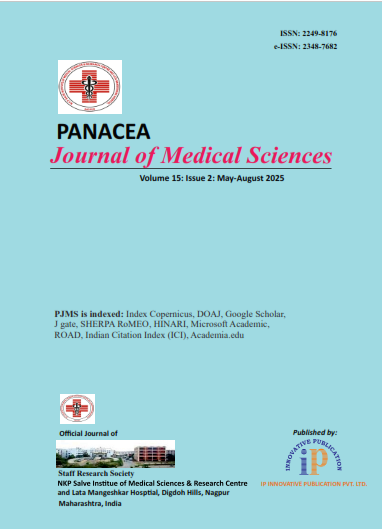Panacea Journal of Medical Sciences
Panacea Journal of Medical Sciences (PJMS) open access, peer-reviewed triannually journal publishing since 2011 and is published under auspices of the “NKP Salve Institute of Medical Sciences and Research Centre”. With the aim of faster and better dissemination of knowledge, we will be publishing the article ‘Ahead of Print’ immediately on acceptance. In addition, the journal would allow free access (Open Access) to its contents, which is likely to attract more readers and citations to articles published in PJMS.Manuscripts must be prepared in accordance with “Uniform requiremen...

Histopathological insights into dysgenetic gonads: A comprehensive case series analysis
Page: 503-506
Normal sexual development relies on the synergistic action of numerous activating and repressing factors interacting in a precise spatio temporal environment. Disorders of sex development (DSDs) can be classified into various categories, usually associated with abnormal development of chromosomal, gonadal, or anatomic sex. Females with DSDs can present with either ambiguous genitalia or with delayed puberty and infertility in later ages. Herein, we report all the dysgenetic gonads cases detected in our setting for a period of 5 years and discuss extensively on the same. This is a retrospective cross sectional study carried out in the histopathology section of Department of Pathology, SCB Medical College and hospital, Cuttack. The total duration of the study was 5years extending from June 2019-June 2024. All the histopathological confirmed cases of sertoli cell syndrome in clinically diagnosed 46 XY phenotypes was analysed. The radiological investigations like ultrasound where collected to confirm the same. We found a total of 10 patients diagnosed with sertoli cell only syndrome in clinically diagnosed phenotypic females. The mean age of patients was 21.11 years with age varying from 15yrs to 29 yrs. Testicular tissue structure identified showed hypospermatogonia with predominant sertoli cells and thickened basement membrane with interstitial leydig cell hyperplasia. Comprehensive evaluation, proper counselling to patients and their parents benefits from review of this information. Chromosomal karyotyping, microarray analyses, and next generation sequencing techniques are helpful to diagnose and identifies new genes involved. Multidisciplinary approach can help in surgery if given consent by the parents and the patient.
Article Metrics
- Visibility 14 Views
- Downloads 5 Views
- DOI 10.18231/pjms.v.15.i.2.500-503
-
CrossMark
- Citation
- Received Date September 04, 2024
- Accepted Date December 16, 2024
- Publication Date August 20, 2025